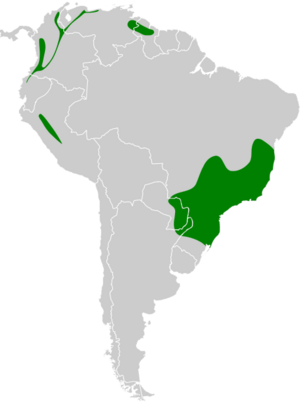Red-ruffed fruitcrow facts for kids
Quick facts for kids Red-ruffed fruitcrow |
|
|---|---|
 |
|
| at Intervales State Park, São Paulo state, Brazil | |
| Conservation status | |
| Scientific classification | |
| Genus: |
Pyroderus
|
| Species: |
scutatus
|
 |
|
| Synonyms | |
|
|
The red-ruffed fruitcrow (Pyroderus scutatus) is a cool type of bird found in South America. It's one of the biggest passerines there, which means it's a large perching bird. It belongs to a bird family called Cotingidae. People in Spanish-speaking countries call it by names like yacutoro or sangretoro. This bird was first named in 1792, and its scientific name is Pyroderus scutatus. There are five slightly different kinds, or subspecies, of the red-ruffed fruitcrow.
Contents
What it Looks Like
This bird has a strong, light blue beak. Its feathers are mostly black. But the most striking feature is a bright patch on its throat. This patch can be dull brown or even bright orange-red, depending on the specific type of fruitcrow. Some of these birds also have brown feathers on their undersides.
Male red-ruffed fruitcrows gather in special areas called leks. Here, they make loud calls to attract females. Females look very similar to males, but they are usually a bit smaller.
Different Types of Fruitcrows
There are five subspecies of the red-ruffed fruitcrow, and they have small differences:
- P. s. scutatus: This type has shiny black feathers and a bright red throat patch.
- P. s. orenocensis: This one is less shiny black and has a full chestnut-colored chest.
- P. s. granadensis: It looks like P. s. scutatus but is much smaller.
- P. s. masoni: This type is black on top and dull dark brown underneath, with a bright red throat and chest.
- P. s. occidentalsis: It looks similar to P. s. masoni but has brighter, more even colors.
Where it Lives
The red-ruffed fruitcrow lives in many separate places across South America. You can find it in parts of Venezuela and Guyana. It also lives on the eastern slopes of the Andean mountains in Peru, Ecuador, and Colombia. You can also spot it in the Atlantic Forest in southeastern Brazil, eastern Paraguay, and northeastern Argentina.
These birds prefer to live in humid forests, especially in highland areas. However, they can also be found at the edges of forests, in lowlands, and even in slightly drier forests.
Where Each Type Lives
- The largest group of P. s. scutatus lives in the Atlantic Forest in southeastern Brazil. Some are also found in eastern Paraguay and northeastern Argentina.
- P. s. orenocensis is only found in a specific part of eastern Venezuela.
- P. s. granadensis lives in the Andes mountains in Colombia and Venezuela.
- P. s. masoni is found in the Andes of northern and central Peru, and has recently been seen in southeastern Ecuador.
- P. s. occidentalsis lives in the western Andes of Colombia and northwestern Ecuador.
How it Behaves and Lives
Reproduction and Life Cycle
Red-ruffed fruitcrows build cup-shaped nests. These nests are usually shallow and made of twigs, sometimes lined with fern leaves. The materials are often thin enough for light to pass through. Usually, a female lays only one egg. Not much is known about how all the different types of fruitcrows reproduce, but we have some information for two of them.
For P. s. granadensis, the nests are shallow and open, built near streams. They consistently lay one egg, and it takes about 22 days for the egg to hatch.
The nests of P. s. scutatus are much stronger and thicker, so light cannot pass through them. These nests are often built on inaccessible branches within ferns, which helps hide and protect them. While most red-ruffed fruitcrows lay one egg, two chicks have been seen in P. s. scutatus nests. Young chicks have brown, thick downy feathers, especially on their heads. Their throats are mostly bare and bright pink, and their beaks are yellow.
What it Eats
Red-ruffed fruitcrows are omnivores, meaning they eat both plants and animals. Their diet includes fruit, insects, and lizards. For adult birds, fruit makes up most of their meals.
Interestingly, what the chicks eat changes as they grow. When they are very young, their parents mainly bring them insects and lizards. As the chicks get older, their diet shifts, and they start eating mostly fruit.
How it Survives
When a red-ruffed fruitcrow's nest is threatened, the parent bird will fly away from the nest and try to chase the danger away. Common threats include predators like hawks or even other fruitcrows entering their territory. P. s. scutatus parents have been seen carefully checking the area around the nest for predators before feeding their chicks. This helps make sure they don't accidentally lead a predator to the nest.
Red-ruffed Fruitcrows and Humans
Local people have sometimes hunted Cotinga birds, including the red-ruffed fruitcrow, for food. This is because the red-ruffed fruitcrow is one of the largest birds in its family.
Status and Protecting Them
Even though red-ruffed fruitcrows are not found everywhere in large numbers, they are still widespread. The IUCN (International Union for Conservation of Nature) lists this species as "Least Concern," which means it's not currently in danger of disappearing globally.
However, many populations of these birds are shrinking. This is probably because their forest homes are being broken up and damaged. For example, P. s. scutatus is listed as endangered in several Brazilian states. This is due to the cutting down of the Atlantic Forest, where many of these birds live. There's also a link between the decline of these fruitcrows and a reduction in the size of palm fruit seeds. When fewer fruitcrows are around, fewer palm seeds are spread, which can affect the palm trees too.



